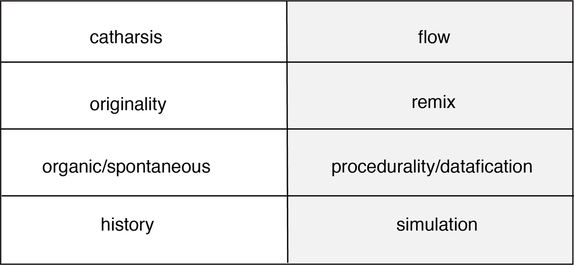The purpose of chapters 1 and 2 was to establish the historical context for what follows: an attempt to describe the plenitude today. My argument so far may make it seem that this is an impossible task, because we cannot identify any single set of characteristics of our contemporary media culture.
what can we do to try to understand our current cultural moment? The strategy I propose is to choose a few characteristics that seem to me to delineate large parts of our media culture. These characteristics can be thought of as aesthetic, social, or technological values or preferences. They can be arranged in pairs, each with its opposite number:
what can we do to try to understand our current cultural moment? The strategy I propose is to choose a few characteristics that seem to me to delineate large parts of our media culture. These characteristics can be thought of as aesthetic, social, or technological values or preferences. They can be arranged in pairs, each with its opposite number:
- Catharsis and flow are contrasting values in entertainment and art. They describe two possible aesthetic or emotional responses in people who listen to music, read novels, or go to films, play video games, and so on. (Chapter 4 and Chapter 5)
- Originality and remix have also become contrasting values in entertainment and art. Remix takes fragments (samples) of the works of others and fashions them into new experiences. Where our culture used to value originality above all else in creative endeavors, remix is now an alternative practice that is widely accepted. (Chapter 6)
- Procedurality is shorthand for a range of technical and social impacts of digit technology and processes. This term (together with datafication) can also describe a fascination with these processes and the way in which communities (such as social media users and video game players) are willing to insert themselves into digital procedures. Its opposite (the organic or spontaneous) includes practices and forms of media that cannot be easily reduced to procedures and data. (Chapter 7)
- Many digital media writers have characterized the computer as a simulation machine, and the key quality of simulation is replayability. We can always reset the variables and play the simulation over. I use the term “simulation” to suggest a way of looking at individual or collective life that is not only ahistorical but anti-historical. Its opposite is a conviction that history is serious, once and for all, and not replayable. (Chapter 8)
